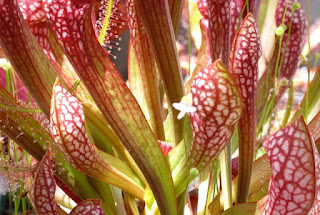The first one is of a baby sundew leaf doing her best impression of a Valentine.
That stem is less than a millimeter wide, by the way, so she's satisfying my love for itty bitty sparkly things pretty well. I also found the limit of how small my camera (a Canon G12) can shoot.
Next is a pair of Venus fly traps, just hanging out in a crowd, waiting for a fly. I think the one on the left just told a joke and the one on the right is laughing at it.

These are American pitcher plants, a particularly brilliant cultivar called 'Scarlet Belle' with some bladderwort flowers, and sundews showing off their sparkling dew. Three different species of carnivorous plants are growing in this one pot.
Here's another sundew, a rotundifolia cross breed. These colors just scream, "Summer!"
Below is a tiny patch of bonus sundews, "weeds" that grew in the pot of one of the American pitcher plants. After I took home these pots, I realized there were entire ecosystems growing in them.
This last photo shows maybe 1.5 inches across of turf. At last count, I found 20 itty bitty sundews in this one pot. Small stuff. Some of them are so small you can barely detect there's a plant, but the dew sparkles in the sun. I'm enjoying their mini-ness. Unfortunately, I haven't figured out how to bead any of these things yet, so you'll just have to be satisfied with the photos. I purchased all of these beautiful, healthy plants from the good people at California Carnivores.






